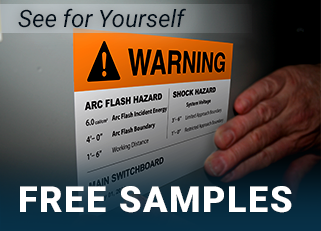Reducing Arc Blast with Effective Short Circuit Analysis
03
February,
2023
4 MINUTE READ

Understanding Arc Blast: What is a Short Circuit?
A short circuit is the flow of current through an unintended path of lower resistance. Short circuits result from unintended connections to ground, two points of different voltages coming into contact, or two phases contacting each other. In many cases the flow of current is through a near-zero resistance connection, resulting in very high current levels that can create an arc blast.
Short Circuits and the Danger of Arc Blast
A short circuit current can be very large. This can result in large, rapid releases of energy in the form of heat, intense magnetic fields, and even potentially as explosions known as an arc blast. The heat can damage or destroy wiring insulation and electrical components. An arc blast produces a shock wave that may carry vaporized or molten metal, and can be fatal to unprotected people who are close by.
What are Bolted, Arcing and Ground Faults?
A bolted fault typically results from a manufacturing or assembly error that results in two conductors of different voltages being "bolted" together, or a source of power being directly connected (bolted) to ground. Since the connectors are solidly bolted there in no arc created and the high current quickly trips a protective device limiting the damage. If the fault current is strong enough, it can lead to an arc blast.
An arc fault is one in which the short circuit creates an arc. The arcing definition is a flow of electricity between two conductors that are not in contact. The resulting intense heat can result in a fire, significant damage to the equipment, and possibly an arc flash or arc blast resulting in serious injuries, depending on the arc flash rating.
A ground fault is when electricity finds an unintended, low resistance, path to the ground. When that path goes through a human body the resulting heat can cause serious burns, and the electrical shock can disrupt the functioning of the human heart (fibrillation).
What are Symmetrical and Asymmetrical Currents?
A polyphase system may experience either a symmetrical or an asymmetrical fault. A symmetrical fault current is one that affects all phases equally. If just some of the phases are affected, or the phases are affected unequally, then the fault current is asymmetrical.
Symmetrical faults are relatively simple to analyze, however they account for very few actual faults. Asymmetrical faults are more difficult to analyze, but they are the more common type of fault.
What are Protective Devices for Short Circuit Analysis and Arc Blast?
Protective devices are designed to detect a fault condition and shut off the electric current before there is significant arc blast damage. There are a number of different types of protective devices to ensure electric hazards don't surpass their arc flash boundary distance and keep workers safe the two most common are:
- Fuses and Circuit Breakers
-
Fuses and circuit breakers are used to protect an electrical circuit from an over-current situation, usually resulting from a short circuit, by cutting off the power supply. Fuses can only be used once. Circuit breakers may be reset and used multiple times.
- Ground Fault Interrupter (GFI)
-
This is a device that detects when the current flow in the energized conductor does not equal the return current in the neutral conductor. The GFI protects people by quickly cutting off the current flow preventing injuries resulting from shock. Ground Fault Interrupters are typically used in homes for bathroom, kitchen, and outdoor electrical sockets. The GFI will typically be built into the electrical socket.
A GFI does not provide over-current protection, and the circuit that includes a GFI will also include a fuse or circuit breaker.
In addition to fuses, circuit breakers, and GFIs, there are electrical protection devices that:
- Detect changes in current or voltage levels
- Suggest an arc flash protection boundary
- Monitor the ratio of voltage to current
- Provide over-voltage protection
- Provide under-voltage protection
- Detect reverse-current flow
- Detect phase reversal
Benefits of Short Circuit Analysis to Avoid Arc Blast
Conducting a short circuit analysis has the following benefits:
- Helps avoid unplanned outages and downtime
- Is critical for avoiding interruptions of essential services
- Identifies an appropriate arc flash boundary distance
- Reduces the risk of equipment damage and fires
- Increases safety and protects people from injuries
- Determines the level and type of protective devices that are needed.
- Provides the information needed for NEC and NFPA required labels
- Keeps you in compliance with NEC requirements
How is Short Circuit Current Calculated to Lessen an Arc Blast?
NEC 110 requires that a short circuit analysis be done for all electrical equipment and panels. The two most common standards for short circuit current calculations are the ANSI/IEEE C37.010-1979 standard and the International Electrotechnical Commission (IEC) 60909 standard.
The ANSI C37.010 standard was intended to be used for power circuit breaker selection, but it does provide the information needed for NEC 110 required labeling. The IEC 60909-3:2009 standard is more generic. It is intended to provide general guidelines for short-circuit analysis of any asymmetrical short circuit in a three-phase 50 Hz or 60Hz A.C. electrical system.
Either the ANSI or the IEC short circuit calculation method can be used. They have been compared and found to produce similar results. The ANSI method is commonly used in short circuit current calculation software. Some feel that the IEC method lends itself to manual calculations.
Arc Blast Solutions from DuraLabel
Easily design and print arc blast safety signs any time you need them, onsite or in the field with DuraLabel's Kodiak Max Industrial Sign and Label Print System. This printer also serves as an excellent facility-wide industrial labeling system to print signs and labels for all kinds of applications and environmental conditions indoors and out.
Get help crafting a system that will provide the safety communication you need. Call 1-888-326-9244 and one of our experts will guide you through the process.
Learn more about electrical safety with the DuraLabel Electrical Safety Instant Action Guide. This guide will improve your warehouse electrical safety by ensuring OSHA/NFPA compliance and utilizing visual communication. Download our free guide on electrical safety below.
Read Next:
RELATED RESOURCES

Arc Flash in Mining
Very little can happen in mining without electricity. From drilling equipment and powered shovels to fixed ...
Read
OSHA and NFPA 70E
When workers performing maintenance or repairs on energized electrical equipment, they could be exposed to an ...
Read
Arc Flash Printers: An Overview
Electrical hazard violations, including arc flash accidents, were the tenth most common OSHA citation in ...
Read.png)




